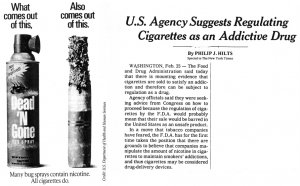
History of tobacco use in American
(Adapted from "Tobacco Timeline" by Gene Borrio.)
The native people of the Americas considered tobacco a gift from the Great Spirit, and they used it in their religious practices. Today, experts believe that the tobacco we know began growing about 8, 000 years ago. Although other plants around the world contain small amounts of nicotine, the drug in tobacco, tobacco is native only to the Americas.
An early explorer of the Americas, Rodrigo de Jerez, brought the habit of smoking tobacco back to Spain around 1504. By 1511, smoking was popular throughout Spain, and by 1531, Europeans were cultivating tobacco, the "sweet" Nicotiana tabacum, in Santo Domingo.
Beginning around the mid-1500s, tobacco was used as a medicine. It was given to patients in a variety of ways, from smoking to enemas. It was believed to be an effective treatment for colic, nephritis, hysteria, hernia, and dysentery, toothache, falling fingernails, worms, bad breath, lockjaw, and cancer, among other illnesses. As early as 1602, however, a connection was made between the cancers and lung diseases suffered by chimney sweeps (caused by soot) and illnesses that could have been caused by tobacco.
As its popularity grew, tobacco gained value. In the American Colonies, tobacco was used as money throughout the 17th and 18th centuries. In fact, in Virginia in 1619, the very first American Thanksgiving celebrated a good tobacco crop.
Acceptance of tobacco use was less than unanimous. In 1628, Shah Sefi punished two merchants for selling tobacco by pouring hot lead down their throats. In 1634 Czar Alexis of Russia created new penalties for smoking. For the first offense, the punishment was whipping, a slit nose, and transportation to Siberia. The punishment for the second offense was execution. A Chinese regulation of 1634 made the use or distribution of tobacco punishable by decapitation. By the 1650s, however, snuff became popular throughout China, and it remained popular there until the early 20th century.
In 1753, Swedish Botanist Carolus Linnaeus named the tobacco plant genus, nicotiana, and also described two species, nicotiana rustica and nicotiana tabacum. He named the genus after Nicot de Villemain, an ambassador who introduced the plant to France in about 1550.
Following a long period of the popularity of snuff, cigars became the most popular tobacco product in England in about 1830. In 1826, England imported about 26 pounds of cigars, but in 1830, 250, 000 pounds of cigars were imported. Cigars gained popularity in the northern United States not long after, with soldiers bringing Latin American cigars back with them after the Mexican War. In the southern states, chewing tobacco remained the most popular form.
The roots of the modern tobacco industry began in the mid 1800s with Philip Morris beginning to sell Turkish cigarettes in London, and J.E. Liggett establishing his tobacco business in St. Louis, Missouri. Matches, which made smoking more convenient, were also introduced at this time.
VIDEO REVIEWS



Share this Post
Related posts
History of tobacco Regulation
National Commission on Marihuana and Drug Abuse THE BAN ON ADVERTISING Both the U.S. Public Health Service and Federal Trade…
Read MoreHistory of tobacco in the United States
600 BC First tobacco plant grows in the Americas 1 BC American inhabitants begin smoking tobacco 1492 Columbus finds tobacco…
Read More










